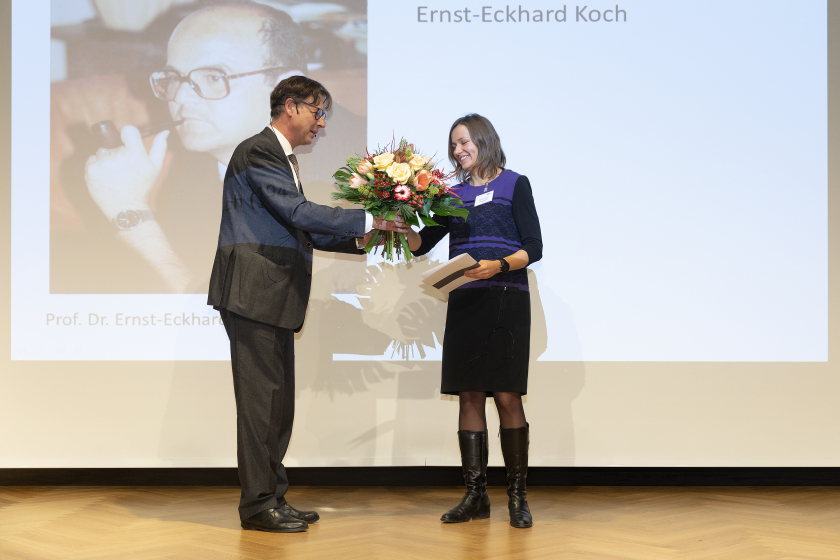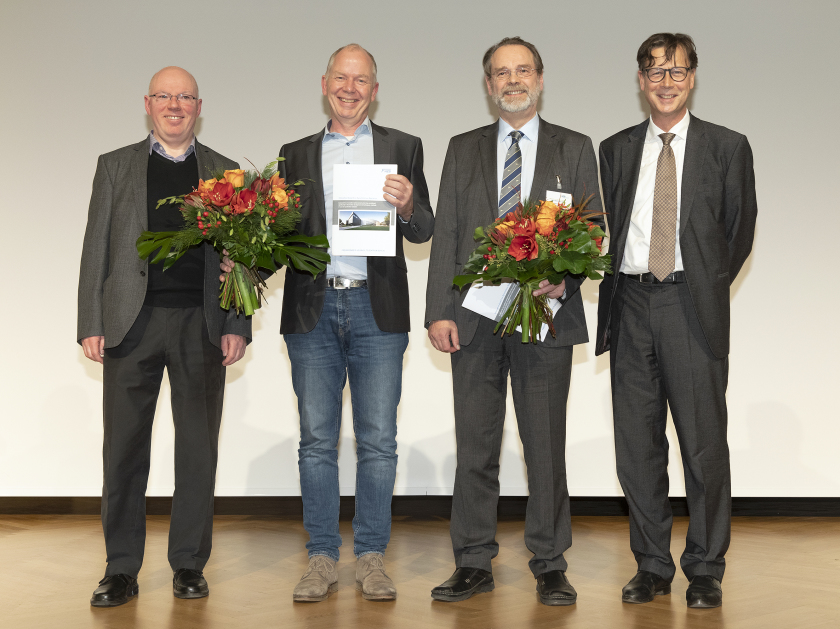Ernst Eckhard Koch Prize and Synchrotron Radiation Innovation Award

The Ernst Eckhard Koch Prize went to Dr. Victoriia Saveleva (right) for her work on catalysts. © M. Setzpfandt/HZB

Laudator Prof. Gerd Schneider, award winners Dr. Christian David and Prof. Alexei Erko and Prof. Mathias Richter, Friends of HZB, (From left to right). © M. Setzpfandt/HZB
On December 6, 2018, the Association of Friends of Helmholtz-Zentrum Berlin awarded the Ernst Eckhard Koch Prize for an outstanding doctoral thesis in the field of research with synchrotron radiation at the HZB or at DESY as well as the European Innovation-Award on Synchrotron Radiation. The award ceremonies took place during the 10th User Meeting at the HZB.
The decisions between excellent proposals have not been easy for the two selection committees, Prof. Mathias Richter, chairman of the “Friends of HZB” pointed out.
The Ernst Eckhard Koch Prize went to Dr. Victoriia Saveleva for her doctorate at the University of Strasbourg on in-situ investigations of electrochemical processes using photoemission spectroscopy. Her experiments at BESSY II focused on reactions on catalyst surfaces of ruthenium and iridium during the electrolytic decomposition of water. Saveleva is now a postdoctoral researcher at the Paul Scherrer Institute in Switzerland.
The Innovation Award on Synchrotron Radiation 2018 went to Dr. Christian David, also from the Paul Scherrer Institute, and to Prof. Alexei Erko, who recently moved from the HZB to the Institute for Applied Photonics (IAP) in Berlin-Adlershof. The two physicists were honored for their innovative contributions to the application of diffractive X-ray optics, which enable complex X-ray experiments with high resolution. The laudation was held by Prof. Gerd Schneider from the HZB. This time it was not the "ring makers" who were honoured for developing the accelerators, but those who had cut the "diamonds for the ring", Schneider explained pictorially. The Synchrotron Radiation Innovation Award is sponsored by SPECS GmbH and BESTEC GmbH.
arö
https://www.helmholtz-berlin.de/pubbin/news_seite?nid=20231;sprache=en
- Copy link
-
Battery research with the HZB X-ray microscope
New cathode materials are being developed to further increase the capacity of lithium batteries. Multilayer lithium-rich transition metal oxides (LRTMOs) offer particularly high energy density. However, their capacity decreases with each charging cycle due to structural and chemical changes. Using X-ray methods at BESSY II, teams from several Chinese research institutions have now investigated these changes for the first time with highest precision: at the unique X-ray microscope, they were able to observe morphological and structural developments on the nanometre scale and also clarify chemical changes.
-
BESSY II: New procedure for better thermoplastics
Bio-based thermoplastics are produced from renewable organic materials and can be recycled after use. Their resilience can be improved by blending bio-based thermoplastics with other thermoplastics. However, the interface between the materials in these blends sometimes requires enhancement to achieve optimal properties. A team from the Eindhoven University of Technology in the Netherlands has now investigated at BESSY II how a new process enables thermoplastic blends with a high interfacial strength to be made from two base materials: Images taken at the new nano station of the IRIS beamline showed that nanocrystalline layers form during the process, which increase material performance.
-
Martin Keller elected new president of the Helmholtz Association
The Helmholtz Association has appointed internationally respected US-based scientist Martin Keller as its new president. Her has lived in the United States for nearly three decades, during which he has held various scientific leadership roles at prominent institutions. Since 2015, Keller has directed the National Renewable Energy Laboratory (NREL) in Golden, Colorado. His term begins on 1.11. 2025.
